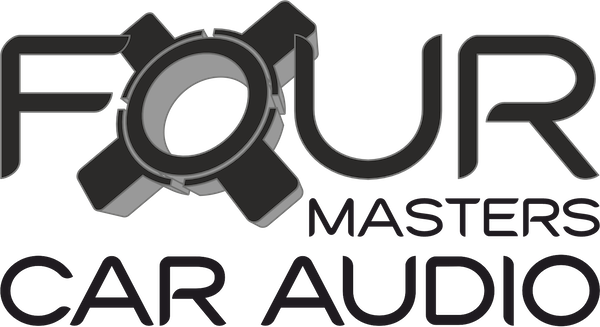
Amplifiers
An audio amplifier is a device that makes a very quiet sound much louder – What could be simpler?
FOUR MASTERS are all for simplification and the above statement is the limit of many people’s knowledge. Some don't even want to know more but a quick look at the number of amplifiers we install would have even the most perfunctory of customers asking questions. The fact is that once you get to specialist level, the performance expectations become much higher therefore, it becomes necessary to employ specialist products.
You may ask why you need an external amplifier at all when upgrading your audio system? The answer is that although the power output of your head unit is probably quoted at 4 X 50 Watts, this is often a peak power measurement rather than the far more useful RMS figure and could be measured with up to 10% distortion. Distortion destroys speakers and ears if you are not careful but it also makes what you are listening to sound less like the original sound recorded by the artist. Also, an on-board amplifier in even a fairly sophisticated head unit is built into a very small box with no room for sophisticated circuitry required to help it run at a high level for long periods of time. A speaker upgrade and improved sound are possible without an amplifier but if you require bass or a large improvement, you will need to add a power horse!
Before we go too far, there is nothing wrong with “general purpose” amplification provided it is designed and built to some general principles which ensure that the signal leaving the amplifier is as close to the signal entering it as possible. We utilise many 4-channel amplifiers to drive classic Audio Joy and Audio Heaven 3-channel systems. This is possible as most of our 4-channel amplifiers allow 2 channels to be added together or “bridged”, effectively doubling the output power available and you will need at least twice the power driving your subwoofer as you will need driving your full-range speakers to achieve anything like the right balance.
There is a direct correlation between amplifier power and the amount of current it consumes and more current means more heat and therefore, even a seemingly small increase in power can mean housing a much larger box in your car. A FOUR MASTER also has to be mindful that sufficient cooling air can flow through the amplifier to prevent overheating. Some amplifiers come equipped with internal fans that suck cold air in and blow hot air out although these are avoided where possible as they too consume current and poor quality ones can create noise also.
High current can be dangerous and it is therefore necessary to keep close control on the performance of an amplifier and to build in safety measures that will shut the amplifier down in case of very rare system malfunction.
In terms of musicality, amplifier design has been refined over many years and there are many different approaches using different types of components. As we are restricted to 12 Volts and need to be careful in terms of power consumption, the most popular amplifier design types or topologies are class AB and class D. Class D is the most recent and extremely efficient offering huge amounts of power from a surprisingly small package. Class D still has some limitations regarding sonic purity with high frequencies and therefore Class D is most common as subwoofer amplification. Some of our amplifiers contain class D subwoofer outputs and class AB full range outputs in the same package and the technology is advancing at a fantastic rate.
A subwoofer only needs to be fed with signals below 80-120 Hz therefore it is common for amplifiers to contain some filtering. It is far easier to filter out unwanted frequencies before the signal has been amplified and therefore it is completely logical to do this within the amplifier. In some cases, depending on system configuration, the whole crossover function can be carried out within the amplifier thus negating the need for an external crossover. We call these filters Hi-pass and Lo-pass and even these will vary in design. But don't worry your FOUR MASTER will know all about filtering so you don't have to!
Finally, it is not wise to select your amplifier on power alone. For a start, the unit for power is logarithmic so a 1000-Watt amplifier is only twice as loud as a 100-Watt amplifier. The most important attribute from a music lover’s perspective is that it makes quiet noises bigger with as little interference to the original sound as possible!
Find out what our partner, The FOUR MASTER Network, can do to bring Hi-Fi quality to your car. Simply put some brief details into the form below.
Not ready for that yet? You can use the same form to book a demonstration at your home, place of work or with your local FOUR MASTER
